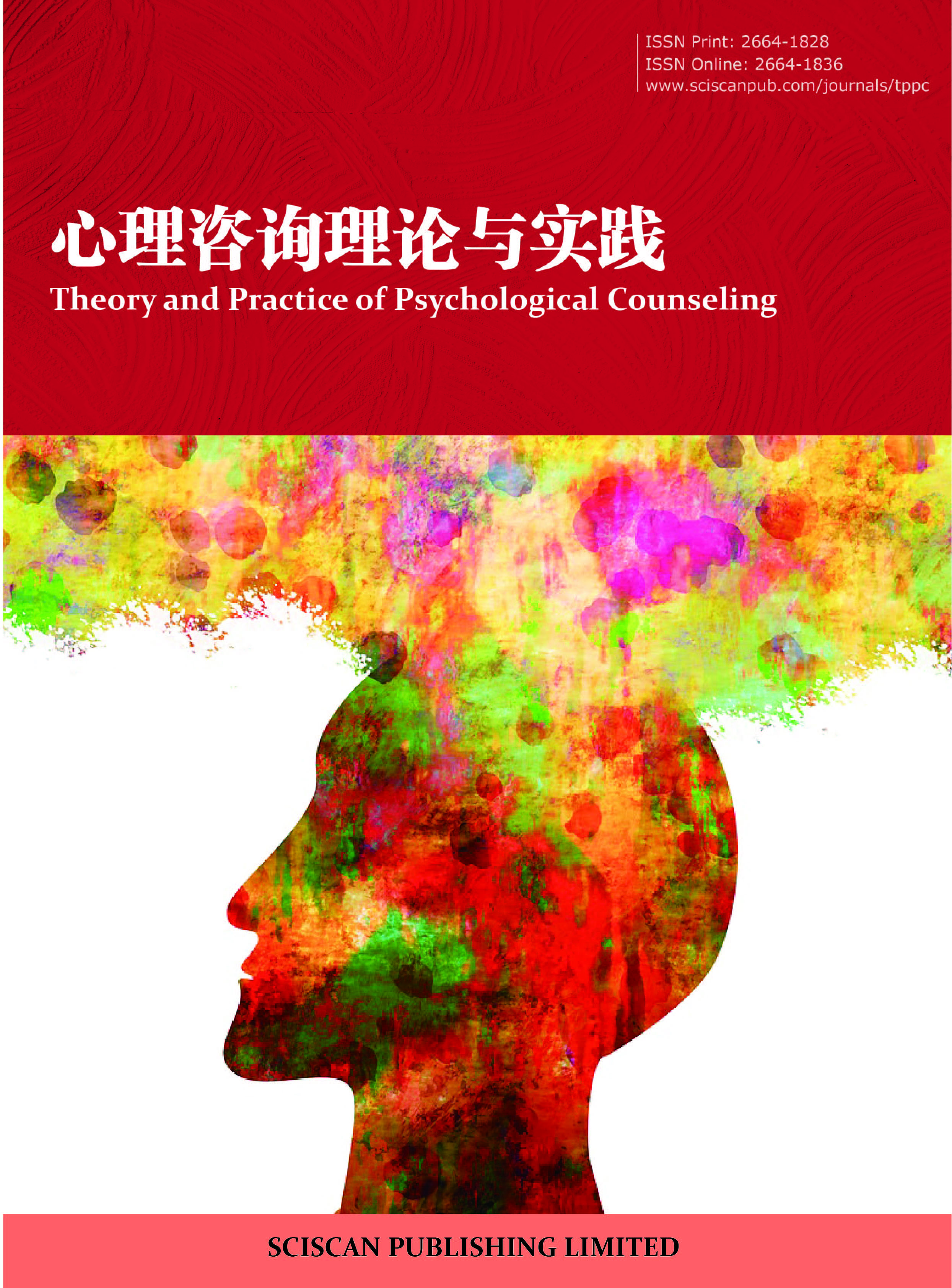Theory and Practice of Psychological Counseling
关于荣格自性的探讨和思考
Discussion and reflection on Jung's self-nature
- Authors: 周曼丽¹* 申荷永¹²
-
Information:
1.澳门城市大学,中国澳门; 2.华南师范大学心理学院,广州
-
Keywords:
Self; Buddha nature. Symbol; Mandala自性; 佛性; 象征; 曼陀罗
- Abstract: Jung's self-nature is the core of collective unconsciousness, which contains conformity, order, centrality and integrity, holiness and transcendence. Jung believed that everyone has their own nature, and the Buddha thought that their own nature is self-sufficient, which is really a coincidence. In fact, whether Buddhism, Taoism and Western Christianity have a "synchronous" relationship, similar to the same. Mandala reveals the source of the patient's subconscious and the intuition of self nature. Mandala reveals the source of the patient's subconscious and the intuition of self nature. In Jung's view, these mandalas are the end of complete self-nature, symbolizing the perfect combination of consciousness and subconscious, and revealing the way that consciousness returns to the subconscious. 荣格的自性就是集体无意识的核心,含有整合性、秩序性、中心与完整性、 神圣与超越性。荣格认为人人都有自性,佛性认为自性本自具足,真是一拍即合; 其实无论佛教,还是道教和西方基督教存在着“同步”的关系,类似异曲同工。 曼陀罗揭示的是病人潜意识的源头和自性的直觉,在荣格看来,这些曼陀罗是 完整自性的终点,象征着意识和潜意识的完美结合,揭示出意识向潜意识回归 的方式。
- DOI: https://doi.org/10.35534/tppc.0205020
-
Cite:
周曼丽,申荷永.关于荣格自性的探讨和思考[J].心理咨询理论与实践,2020,2(5):243-251.
https://doi.org/10.35534/tppc.0205020
1 荣格自性的基本概念
荣格在佛洛依德的基础上将无意识分为个体无意识和集体无意识。个体无意识主要由情结构成,集体无意识主要由原型构成,而自性就是集体无意识的核心。
荣格也将自性作为人格的核心。在荣格看来,自性是内在心灵结构和次序的准则,它代表了心灵的整体性。心灵是一个自我管理的系统,它总是趋于平衡,这种效果就来自作为心灵组织中心的自性。例如,如果个体的意识态度过于极端或者失衡,那么自性就会通过无意识的补偿作用来使心灵获得平衡。
荣格自性概念包括四个方面:整合性、秩序性、中心与完整性、神圣与超越性。整合性是指心理对立面之间的整合。这主要包括:意识与无意识的整合;心理类型的优势功能和劣势功能的整合;自我与阿尼玛(阿尼姆斯)以及人格面具与阴影之间的整合。秩序性是指在整合众多对立面的基础上所体现出来的和谐有序的状态。换言之,秩序性是体现于整合性的基础之上的。荣格与弗洛伊德分道扬镳之后,很长时间都感觉自己失去了方向,陷于精神崩溃的边缘。在那段艰难的时间里,荣格通过自发画曼陀罗维持内心的平衡和秩序。心理紊乱的病人,通过在无意识的情况下绘画曼陀罗减少内心的紊乱,维持内心秩序。病人通过绘画曼陀罗所表达的正是完整、秩序和平衡。荣格认为,自性既是心灵的整体,也是心灵的中心。心灵的完整性是由意识和无意识相互补偿而形成的。自性超越意识自我,既包括意识,也包括无意识。四方体或曼陀罗的意象经常被用来表现自性作为心灵的整体性。所有对立面的统一都被象征性地暗含在曼陀罗图案之中。它既包含阴与阳,也包含地狱与天堂。荣格把自我和自性二者做了区分,自我是意识的主体,具有适应社会功能。自性是个体心灵整体的主体,既包括意识,也包括无意识。自我以自性为中心如同卫星围绕自性转动。自性能起到保护自我的作用。具有神性的自性比自我更为核心。比自我更加优秀的人物的出现对于个体来说经常象征着自性。荣格在《爱翁》中阐述到,象征自性的可以是某个人物形象也可以某种动物的意象。成为自性象征的人格优越的人物可能是父母、叔舅、国王、皇后、王子和公主等角色形象。成为自性象征的动物意向,可能是如大象、马、牛、熊、鱼及蛇这样的可以代表个人部落和民族的图腾的动物,这些意象象征着比自我人格更为伟大的集体自性。自性经常与具有神圣性的宗教意象联系在一起。荣格认为,自性原型可能会以上帝、佛陀、超人或智慧老人等这样的形象在梦中或处于冥想状态时出现。荣格认为神的意向不等同于上帝本身,或者不能用自性去替代上帝。自性仅在心灵的完整性意义上和神的意向相吻合。[1]
2 佛陀与自性
慧能在《六祖坛经·行由第一》说:“何期自性本自清净;何期自性本自具足;何期自性本无动摇;何期自性能生万法。”自性即佛性,荣格认为人人都有自性,就像禅宗认为人人皆有佛性。荣格心理学阐述的自性,正是佛教强调的一个开悟的过程。在走向自性完满的道路中,佛陀身体力行苦修,认识到单纯的身体禁欲并不能获得精神解脱达成自性。[2]
自我识见本心,自我识见本性,原本就没有顿悟和渐悟的差别。愚钝的人通过渐次修行,和聪明人在修行中产生顿悟,能够达到同样的明心见性的最高境界。修行者应该做到无相、无念和无住。自性作为人格的核心,是那种的心灵结构和次序的准则。追求自性,超离一切外在形相,叫做无相。以无相为本体,就是自性法体清净。追求自性,在世间万事万物中不被浸染,叫做无念。本性痴愚的人,对俗尘事物产生执着心念,引发邪见和妄想。通过某种具体方法并不能达成自性。没有事物的差别对立,没有二分之相,即是“无”。自我本性是与佛性相一的心念,如来佛性的心念,有别于通过眼耳鼻舌等感觉器官产生的心念。自我自性,也就是真如佛性。感觉器官虽然能感知到外在一切事物现象,但是不被凡尘俗事浸染,始终保持真如本性,没有生灭。走向自性,就是要摒弃对过去,现在或者是将来的过度的执着,摆脱自我系缚的控制。[3]
荣格认为,心灵是一个自我管理的系统,它总是趋于平衡,这种效果就来自作为心灵组织中心的自性[2]。六祖慧能的法门以定、慧为根本。定和慧是平等一体的。禅定是智慧的本体,智慧是禅定的功用。修禅可以帮助我们达成心灵的平衡走向自性。无论时间地点,或行或住,或坐或卧,都可依照本心修行[3]。自性化是荣格分析心理学的核心概念。它所表达的是一个人最终成为他自己,是不同于他人的具有整合性、不可分割的发展过程。自性化是人格的完善与发展。自性化包含与集体的关系,表明它不是孤立状态发生的[2]。
荣格认为,轮回观是“人类的原始肯定”,其心理基础是原型。卫礼贤将人格理论与轮回学说进行联系和深度阐述。佛教观念认为人死之后或者升天堂或者下地狱。卫理贤认为,人死之后,阿尼马斯会渐渐上升,最后化为虚空。阿尼玛会下降,最后沉沦于无边的黑暗。[4]
卫礼贤认为,佛教,道教和西方基督教存在着“同步”的关系。宗教的最终目的,是通过实现意识和潜意识的统一达成自性的一个过程的完成。在杰弗瑞·芮夫看来,“宗教态度关注自性,并使之成为内在的伙伴”。荣格在自性层面实现了心理学与佛教的互通。通过开悟和对轮回观的体会帮助个体达成自性。荣格心理学的核心是自性。人格的形成依靠自性提供明确的方法。有所不同的是,佛教强调个体通过修行可以达到完全意义上的自性。人最终可以摆脱轮回之苦,实现圆满,往生西方净土。荣格认为个体不能完全意识到自己的无意识的全部内容,个性化的过程也是没有终点的。而大成佛教认为通过开悟了解所有的未知,一切都是有可能的。可见佛教比荣格的学说更加终极彻底。佛教把轮回说和因果报应等紧密地联系在一起,即“众生由惑业因而招感生死流转”。善有善报,恶有恶报,一切皆有因果。世间万物,皆有轮回,皆有定数。佛教这种超自然学说尚未被心理学领域所接受,但不能对理性地解读荣格理论与佛陀教义形成壁垒。卫礼贤的《太乙金华宗旨》使荣格走出了和弗洛伊德分裂后的黑暗的心灵低谷。佛教的思想为荣格奠定了基础,荣格结合心理学的理论解释了佛陀的教义。[5]
3 基督:自性的象征
基督是自性原型的典型。圣奥古斯丁(公元354—430)对两种上帝形象的区分:一种是基督的形象。另一种是为形若上帝而植入人身的形象。并且强调上帝之形象在理性灵魂(anima rationslis)之中,因此上帝的形象与理性灵魂本无二致。基督是第二亚当,是上帝形象的化身。圣奥古斯丁强调基督的“总体性”,充满于人的身体和灵魂,指的是人在自身呈现的一种完全的人类灵魂。被损害和腐蚀的人的上帝意向(God-image),可有上帝的恩典恢复,并不会因堕落而毁灭。统合之见让人想到主对所有人类的灵魂包括下降冥府的亡者的救赎。人的灵魂与上帝之道结合,使二者合为一体,这与基督和教会的神秘婚姻一致。教义中的圣婚和教会的礼拜,在中世纪发展为炼金术里对立面的结合(或“化学婚配”)。进而产生的哲人石的概念,意指“总体”,有化学上的化合的概念。在个体化的过程中,无意识所制造的全部意象,都是先验的原型(曼陀罗)在起到“修复”的作用。自性自发生成的象征或“整体性”,类似于上帝意象。心灵的“更新”是一种意识原初状态的恢复和复原,并不意味着意识实际上的改变。“整体性”原型一直都是存在于集体无意识之中,但是完全没有被意识所觉知,或者因为某种原因轻易地从意识范围中消失。人们在基督形象中认出“整体性”原型,恢复了人与上帝意象合为一体的原初状态,整合了被压抑的本能导致的人格分裂。基督呈现的“上帝的形象”,甚至包含了人的兽性的一面,在最初被认为是一个包含了整体性的概念。然而,基督象征后来被发现缺乏心理学意义上的“整体性”。基督象征将万物的黑暗的一面或者说邪恶力量排除在外,但俄利根提出的“善之缺乏”教义认为恶是善的减少,恶丧失了其实在性,成为阴影部分。“善之缺乏”的教义,使“整体性”在基督的形象中得以保证。然而,人们在心理上必须把善与恶当作等价的对立面。[6]
自性的内容部分来自全体人类的知识,其余部分是无意识的产物。无意识生成了原型式的,与内在矛盾相连的原型式的四位一体。如果类比自性与基督的传统形象,那么敌基督就相当于自性的阴影。阴影是人类整体中黑暗的一面,自性的概念不能忽略阴影面。但在基督教里,光明和阴影被划分为互不相容的两半,是一个形而上的二元论。与圣父的同质性、永恒性、孤雌生殖、受难、羔羊献祭、一分裂为多等都是基督的属性,由此可见,基督是自性的体现。然而从心理学角度分析,基督只代表了原型的一半,另一半则体现在敌基督上。敌基督,代表了黑暗的一面,也同样体现了自性。[6]
4 曼陀罗的象征
治疗师不是通过暗示让他的病人创造曼陀罗图画。曼陀罗揭示的是病人潜意识的源头和自性的直觉。曼陀罗体现了病人对自性的觉知和潜意识对生命的奉献。曼陀罗不只是病人的内心一种表达方式,而且具有实际的情感治疗功效。曼陀罗蕴藏着的神秘的力量,被称为“封闭的圆圈”或者“有魔力的圆圈”,并以很多种民间习俗的方式被保存了下来。曼陀罗包含了生命和意识的统一,开启了特定个体的自性之旅。
《金花的秘密》揭示了《太乙金华宗旨》中的奥秘。金华是光,天光是道。金华是一个曼陀罗,火一样鲜艳色彩的光之花。这样的绘画表达了金华的起源,在《慧命经》中,“窍”就是“黄庭”“天心”“灵台”,是“修慧命之坛”。在窍里,意识和生命(性命)是一个整体,“似炉火中之火种”“夫窍内有君火”“凡圣由此而起”。在欧洲曼陀罗的图画中,类似植物种子的东西在水中漂,在水的深处,有类似道教的火焰穿透种子助其成长,形成一朵硕大的金花。这种象征指的是一种提炼和升华的炼金术过程。在生命成长的过程中,潜意识的东西变成意识的,性和命联结成为一个整体。人的本性(性)和意识(慧)用光的象征表示,因此有强度,有阳的特点:生命(命)则与广度相一致,有阴的特点。
在东方文化中,道指的是性和命两者的统一。道是一个独立存在的混沌整体。道生出天地,蕴含着阴阳二气,阴阳二气相交冲而形成和谐之气,于是就产生了万物。道不能被言说,不能被命名。道的象征应该是中间的白光,也就是《西藏度亡经》的中阴身。“环绕”,或者“回光”就是太阳按照自己的轨迹开始运动,有了光明和黑暗的两极交替或者说是白天与黑夜交替。道开始运行并主导万物,有为转向无为,所有次要的事物都要受制于核心事物。从心理学的观点来看,回光就是“围绕自己转圈”,这样一来人格的各方面都被包含其中。回转的运动激活了所有对立的心理力量,个体通过自我修持顿悟,成为一个完美的柏拉图式原型的人,圆融通碍而且雌雄同体。[4]
自性具有完整性,而曼陀罗是自性完满的象征,是一种原型性意象。荣格对《太乙金华宗旨》的分析中,列出了10幅西方曼陀罗图案。荣格发现这些曼陀罗和东方佛教的曼陀罗存在形式上与内涵上的相似性和一致性。曼陀罗的背后隐藏着高深的佛教智慧,荣格在他的心理学思想中讨论了曼陀罗的意义。荣格认为,以金花的形式出现的曼陀罗是最神圣的。在荣格列举的10幅曼陀罗图案中,被荣格列在首要位置的曼陀罗图案最为完美复杂,全部由大小各异的金花组成。它的中心是一个让人印象极其深刻的巨大的金花,绽放着灵魂向往延展,周围细碎的金花与其相呼应。每一朵金花都可以被看作独立的曼陀罗,象征心灵的不同面向,他们相互区别,相互依赖,和相互交织。
在荣格看来,这些曼陀罗是完整自性的终点,象征着意识和潜意识的完美结合,揭示出意识向潜意识回归的方式。通过绘画曼陀罗可以整合意识和无意识的冲突,可以避免和治愈心灵的分裂。曼陀罗的中心即是人格的中心,绘画曼陀罗的过程可以看作人格自我塑形的过程。通过绘画曼陀罗,病人可以领悟生命的意义,发挥自己的心理类型的功能,以及明确未来的人生方向。曼陀罗的边缘可以起到壁垒的作用,保护完整的人格。曼陀罗看上去虽然是一个封闭的图案系统,但是它主动和外在世界接触并对外在信息进行接纳,并且能够排斥邪气的入侵。曼陀罗是自性的象征:以自性作为灵魂的中心,原型按自己的秩序分组。曼陀罗是“封闭的圆圈”或者说“有魔力的圆圈”,为了防止元神的外泄,在最核心的自性周围具有保护性的壕沟。外部事物造成的偏离,则使用辟邪物防止。曼陀罗反映的是人的心理事件的投射,在日常生活中,尤其是心理治疗中被反过来作用于人的心理,隐藏着神奇的心灵力量。荣格相信宗教的互通性,在荣格看来,曼陀罗融合了道教,佛教以及民间神秘力量等的多种成分。《太乙金华宗旨》原本就是传入中国的佛教和传统中国道教的结合产物。曼陀罗具有宗教意义上的普遍性,涵盖了几乎所有的宗教智慧。[5]
参考文献
[1] 陈灿锐,申荷永.荣格与后荣格学派自性观[J].心理学探新,2011(5):391-396.
[2] 王文龙,赵海鹏.论荣格的自性观与健全人格的培养[J].心理素养,2017(10):94.
[3] 陈秋平,尚荣译注.坛经 心经 金刚经[M].北京:中华书局,2016:243.
[4] 卫礼贤,荣格.金花的秘密[M].邓小松,译.北京:中央编译出版社,2016.
[5] 常如瑜.通往佛陀的自性之路——荣格视角下的佛教生态思想探析[J].中州大学学报,2018,35(2):14-15.
[6] 荣格.自我与自性[M].赵翔,译.北京:世界图书出版公司,2017.
















